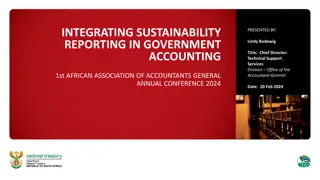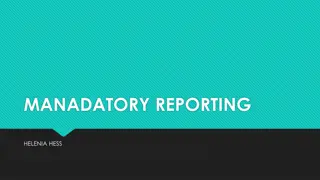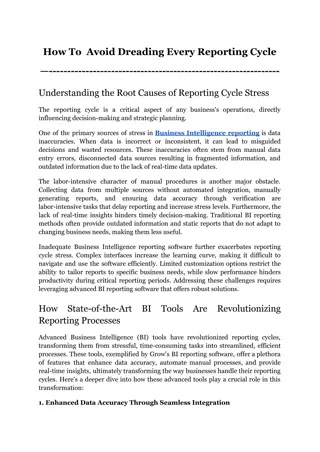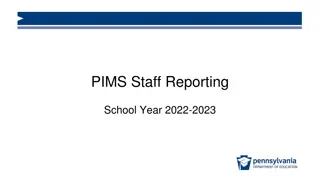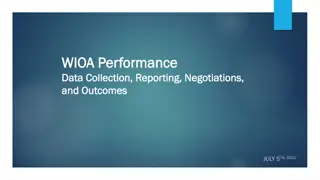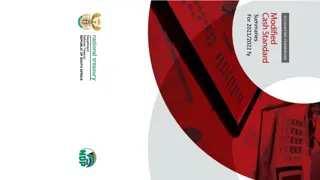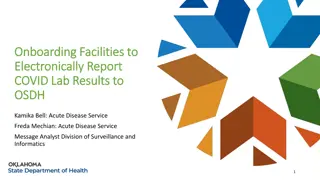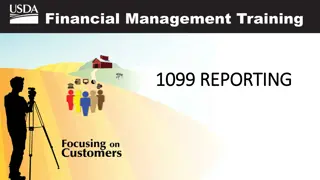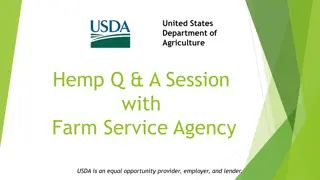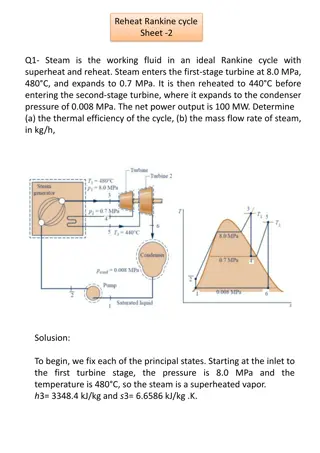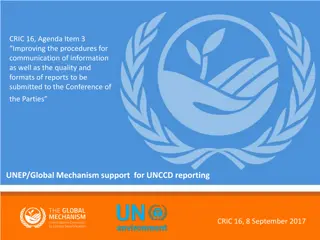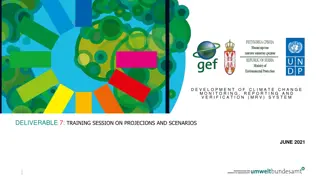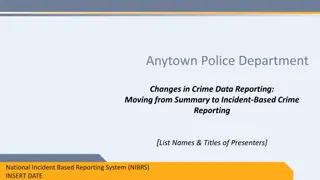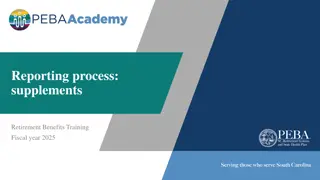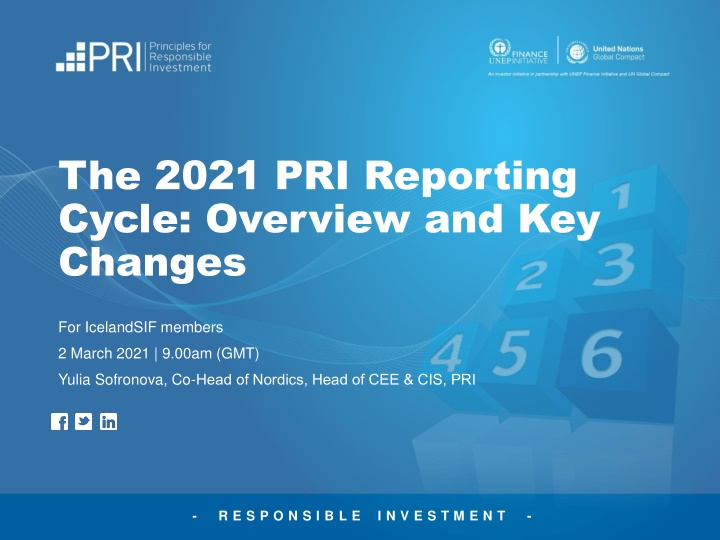
Key Changes in 2021 PRI Reporting Cycle for IcelandSIF Members
The 2021 PRI Reporting Cycle brings significant changes for IcelandSIF members, including an overview of the investor reporting framework, assessment methodology, and new reporting platform. With reporting deadlines and mandatory requirements, signatories must navigate these updates to maintain their status. The introduction of Core and Plus models simplifies the reporting process, while the focus on ESG processes challenges signatories to enhance their incorporation of ESG factors. Stay informed and adapt to ensure compliance and robust reporting practices.
Download Presentation

Please find below an Image/Link to download the presentation.
The content on the website is provided AS IS for your information and personal use only. It may not be sold, licensed, or shared on other websites without obtaining consent from the author. If you encounter any issues during the download, it is possible that the publisher has removed the file from their server.
You are allowed to download the files provided on this website for personal or commercial use, subject to the condition that they are used lawfully. All files are the property of their respective owners.
The content on the website is provided AS IS for your information and personal use only. It may not be sold, licensed, or shared on other websites without obtaining consent from the author.
E N D
Presentation Transcript
The 2021 PRI Reporting Cycle: Overview and Key Changes For IcelandSIF members 2 March 2021 | 9.00am (GMT) Yulia Sofronova, Co-Head of Nordics, Head of CEE & CIS, PRI - R E S P O N S I B L E I N V E S T M E N T -
AGENDA Investor reporting framework overview: snapshot and timelines Key changes to 2021 investor reporting framework and modules overview Assessment methodology Navigating the new reporting platform Resources Q&A session 2
Overview of Investor Reporting Framework 3
2021 Reporting timeline Reporting is mandatory for all signatories to maintain their signatory status August Reporting outputs released November July November Feb April May - July Release of next year s reporting framework Module development and changes to the framework PRI signatories report on RI activities Data analysis and creation of reporting outputs Live reporting period Online Tool Closed Investor reporting cycle deadline: 29 April 2021 4
Investor Reporting Framework Modules and short guides are downloadable at Investor reporting guidance 5
Key changes to the 2021 Key changes to the 2021 Investor Reporting Investor Reporting Framework Framework 6
Simpler, shorter and more consistent Introduction of Core and Plus model to simplify the reporting process Decrease in number of indicators compared to 2020 ~50% CORE PLUS Voluntary Public or private (signatories choice) Not assessed Evolving Process- and outcomes focussed Mostly open-ended questions Mandatory Public Assessed Relatively stable Process-focussed Closed-ended questions PLUS 30% 70% CORE 7
Evolved and more challenging The modules are more challenging because they focus on the robustness and depth of signatories ESG processes Evolved Aligned with existing PRI work Process oriented Capturing robust ESG incorporation How ESG factors are incorporated Depth Understanding the depth of ESG activities AUM coverage for a practice 8
Senior leadership statement To raise awareness and accountability of PRI reporting Signed by senior leadership (CEO, CIO or similar) Introduces reporting outputs Overview of signatory s approach and achievements on RI Not assessed Mandatory for all signatories 9
Structure of the statement Four Sections 1. Our commitment 2. Annual overview 3. Next steps This year's progress on RI, achievements, etc. Plans for next 2 years Why we engage in RI Overall approach to RI How RI adds value to our activities 4. Endorsement signed by senior leadership Providing their name and position Endorsement limited to the SLS,not to all the information reported in the RF 10
Organisational Overview Mandatory for all signatories to report on i.e. all Core indicators Acts as a gateway to the rest of the Reporting Framework Assets under management [OO 4] signatories to complete by 31 March Assets class breakdown and sub-strategies [OO 5] ESG incorporation [OO 10, 11, 12, 13] affects assessment Reporting on voluntary modules [OO 14] 11
Investment & Stewardship Policy (ISP) Covers firm-wide RI themes that are applicable across all assets and is mandatory for all signatories to report on Module sections POLICY & GOVERNANCE -21% STEWARDSHIP CLIMATE CHANGE SUSTAINABILITY OUTCOMES TRANSPARENCY & CONFIDENCE-BUILDING MEASURES 12
Investment & Stewardship Policy (ISP): minimum requirements The minimum requirements are clearly highlighted in orange and captured in the policy and governance section of ISP. See minimum requirements for investor membership for more information. How the minimum requirements indicators map from old SG module to new ISP: Example of the minimum requirements indicator in ISP: 13
Investment & Stewardship Policy (ISP): stewardship Stewardship not assessed in separate module included in module scores ? Stewardship not assessed in separate module included in module scores Extensively covered in the ISP module to avoid repetition Extensively covered in the ISP module to avoid repetition aligned with STW 2.0 paper aligned with STW 2.0 paper Stewardship incorporated throughout the framework In relevant asset class modules for asset-specific stewardship practices practices In relevant asset class modules for asset-specific stewardship More space to report on (proxy) voting, shareholder resolutions and engagement with policy- makers voting, shareholder resolutions and engagement with policy- makers More space to report on (proxy) The indicators are aligned with the PRI s paper Active Ownership 2.0 14
Investment & Stewardship Policy (ISP): climate change Climate change-related indicators mandatory in 2020 will now be in core section Climate change-related reporting Anchored to the 11 TCFD Governance recommendations Strategy Strategy & governance: CORE Risk management and Risk Management Metrics/Targets: PLUS Mostly multiple-choice questions, Metrics and Targets with additional free-text answer boxes 15
Investment & Stewardship Policy (ISP): sustainability outcomes Sustainability outcomes There are 6 CORE outcomes-related indicators in the ISP module A separate Sustainability Outcomes module entirely PLUS All of the sustainability outcomes indicators are aligned with the SDG paper The indicators are aligned with the PRI s paper Investing with SDG outcomes: a five-part framework 16
Listed equity and Fixed income Mandatory to report on if either 10% of AUM, or US$10bn or more, is directly invested in the asset class in the reporting year and implement responsible investment for at least some of those assets Aligned on content, structure and themes Listed Equity -52% Allows differentiation of responses by sub-strategies or sub-asset types Fixed income -39% LE module includes indicators on stewardship, specifically voting FI module includes new indicators on private debt, securitised products and engagement for sovereign bondholders 17
Alternatives: Private equity, Real estate and Infrastructure Mandatory to report on if either 10% of AUM, or US$10bn or more, is directly invested in the asset class in the reporting year and implement responsible investment for at least some of those assets Alternative modules indicators are aligned Private Equity -54% Reduced open-ended/narrative indicator types Real Estate -56% Reduced logic within the modules More focused questions on due diligence, materiality analysis and monitoring Infrastructure -56% Infrastructure module mandatory to report in 2021 18
Alternatives: Hedge funds Mandatory to report on if either 10% of AUM, or US$10bn or more, is directly invested in hedge funds in the reporting year and implement responsible investment for at least some of those assets Aligned with listed equity and fixed income modules on content, structure and themes -19% Allows differentiation of responses by hedge fund strategy, where relevant Indicators on (proxy) voting practices for equity-linked strategies Assessed for the first time in 2021 Technical guide: ESG incorporation in hedge funds Further guidance found in Technical guide: ESG incorporation in hedge funds Technical guide: ESG incorporation in hedge funds 19
Selection, Appointment and Monitoring (SAM) Mandatory to report on if either 10% of AUM, or US$10bn or more, is indirectly (externally) invested in an asset class in the reporting year and implement responsible investment for at least some of those assets Aligned with latest SAM guidance SAM guidance -15% Asset class split (active/passive) Active Ownership 2.0 New stewardship indicators aligned with Active Ownership 2.0 Active Ownership 2.0 2 PLUS indicators on sustainability outcomes Captive relationships linked to [OO 7] 20
Sustainability outcomes Introduces a new focus which goes beyond financially material ESG analysis and incorporation All signatories can report on this module PLUS module = voluntary to report on and to disclose, and not assessed 32 indicators Unlocked based on the response to ISP 45 Shape and track the sustainability outcomes of activities Investing with SDGs outcomes: a five-part framework Aligned with PRI guidance - Investing with SDGs outcomes: a five-part framework and Active Ownership 2.0 Investing with SDGs outcomes: a five-part framework Active Ownership 2.0 21
The new assessment process How PRI assessment is changing in 2021 Previous assessment process Module grading Percentage 3 stars max 0-100% E-A+ 0-3 stars New assessment process 100 points/ question Variable weightings Module level stars Percentage* 0-100 x1, x1.5, x2 0-100% 1-5 stars *Percentage calculated as total points achieved/total points available (only considering indicators applicable for the signatory) in the module 23
Assessment in the Reporting Framework modules The indicator level assessment methodology is explained under each indicator in the offline version of the Reporting Framework Assessment Assessment criteria Indicates the basis for assessment or Not assessed . Other scored as Indicates whether, and how, selecting Other as an answer option is scored. All indicators have 100 points available to be scored within the initial phase of assessment. A multiplier is then applied, weighted according to the indicator s importance relative to other indicators. High importance indicators are weighted x2. Moderate importance indicators are weighted x1.5. Low importance indicators are weighted x1. Multiplier 24
Module level assessment Moving away from the A+-E to a numerically based five-star grading system to reflect that scores for the 2021 reporting cycle cannot be compared to previous years Best Middle Little & no ESG Allocated per module, with no overall organisation score 25
Navigating the new reporting platform 26
Recommended steps to complete reporting Using available guidance on the dedicated reporting webpage 1 Use the mapping resource 2 Collect information offline and review 3 Start with the Organisational overview module 4 Input responses in the reporting platform 5 Final review before submitting 27
Accessing the platform You can access the reporting tool via PRI s webpage New users can register at account.unpri.org/register 28
New dashboard To see high-level information of the signatory organisation 29
Navigating the survey (1) Key features of the new reporting tool Choose one person to report at a given time ? Stewardship not assessed in separate module included in module scores Respond to CORE (or mandatory) indicators before continuing Extensively covered in the ISP module to avoid repetition aligned with STW 2.0 paper In relevant asset class modules for asset-specific stewardship practices navigate the survey Use the table of contents to More space to report on (proxy) voting, shareholder resolutions and engagement with policy- makers PLUS (or voluntary) indicators at the end of a module Choose disclosure setting for 30
Navigating the survey (2) What the new reporting platform looks like Further details can be found in the user guide available once logged into the tool 31
Providing voluntary feedback We welcome signatory feedback throughout the pilot reporting cycle of the new Reporting Framework 32
Resources More information and resources about Reporting and Assessment available at www.unpri.org/reporting The reporting process Investor reporting guidance Short module specific guides Mapping documentation Offline version of the Reporting Framework, including explanatory notes (PDF, MS Word and Excel format) Reporting framework glossary Service providers reporting guidance How investors are assessed on their reporting Reporting and assessment review Minimum requirements for investors membership and Leaders Group 33
Q&A 34
Thank you Contact: yulia.sofronova@unpri.org or Reporting & Assessment at reporting@unpri.org 35


